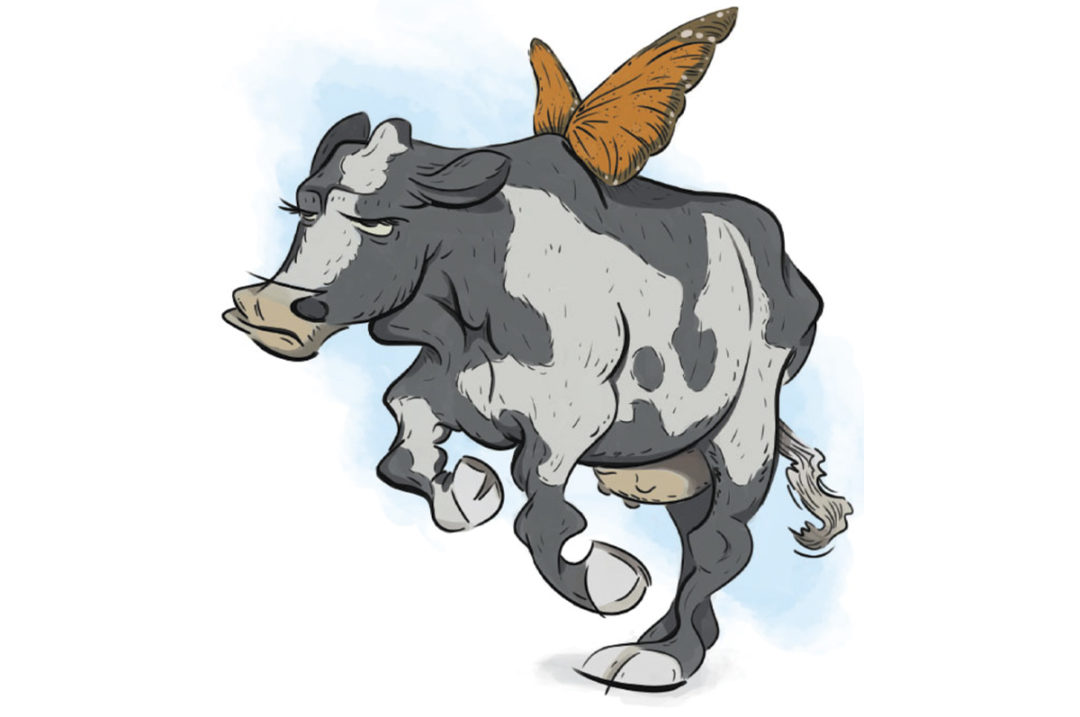In the first 72 hours, her body is transforming from maintenance to high performance. Her body is being transformed like a caterpillar into a butterfly.
Her body, that was at maintenance during the dry period, emerges in 72 hours primed to produce 100 pounds and eventually 150 pounds of milk a day.
About 15% of skeletal calcium disappears in a cow in early lactation. She mobilizes that calcium to supplement dietary calcium until her intakes and absorption meet her requirements. In the first 72 hours, a lot of biochemistry is going on to get this system up and running. Various diet treatments (like DCAD) in the dry period prime the pump. These special diets trigger the cow to start mobilizing calcium (Ca) at the cellular level before she calves. In the first 72 hours, if the pump is primed correctly, her blood Ca dips slightly in the first 24 hours and quickly rebounds. Kidneys retaining Ca, increased intestinal absorption of Ca, increased intake and bone resorption work together to help this butterfly take off.
Producing milk requires energy – lots of it. The cow needs an engine to produce this energy, and perhaps the liver is one of the most important engines to keep the cow running. During mid-lactation, the liver is humming without complication. In the first 72 hours, if this engine gets clogged (i.e., fatty liver), multiple problems can occur, including ketosis, DAs, etc. Too often on dairies, we look to treat ketosis without understanding what caused it. Heavy cows and higher-energy pre-fresh diets will result in fat mobilization that clogs the engine. But retained placentas, mastitis, stress can all increase fat mobilization as well and lead to the same results. Healthy cows with high intakes keep this engine running smooth.
The mystery system, perhaps, in the cow is the immune system. It’s very complicated. When the immune system is suppressed, we have more retained placentas (the immune system “rejects” the placenta), more mastitis, etc. What is the best way to keep the immune system healthy? Beyond feed additives, vitamin E, selenium, we should never forget the basics. For the average person, when they are run down because they are overworked and sleep-deprived, they are more likely to come down with a cold; their immune system is suppressed. When a cow is stressed due to poor cow comfort, poor air quality, poor nutrition, disease (think Johne’s), her immune system will be suppressed. That might not cause major problems in the dry period with the dormant caterpillar, but the emerging 100-pound cow needs this system to keep her running.
Focus on the farm level
With a fresh group of 100 head or more, it’s hard to focus on every cow. Identifying those cows in the first three days after calving can be helpful. If there is a specific focus on these cows, problems at 14 days will be less common. In the past, taking temperatures of every cow helped identity potential issues early on. Many farms have utilized ketone strips to identify subclinical ketosis. There has been discussion related to measuring calcium status on early lactation cows to identify subclinical hypocalcemia. While all of these have merit, the real question is: What then? I think some farms have overidentified and overtreated some cows.
A couple of examples. First, a cow is eating well, her eyes are perky, and she registers 1.4 on the ketone test. Technically, according to the experts, she is subclinically ketotic. Do you treat her? I would lean toward no. We think that having absolutely no subclinical ketosis would be ideal, but is that true? I am much more interested to see if she is eating aggressively than what the ketone stick is saying. Second, someone comes into the farm and identifies a subclinical hypocalcemia issue on the farm through extensive blood sampling.
Now what do you do? I’ve seen some farms use a calcium bolus at 12 or 24 hours to help the cow along, with the thought they are helping reduce this subclinical hypocalcemia. That may actually help for 12 hours, but at the same time that bolus at 12 to 24 hours is shutting down the natural response mechanism in the cow. Low blood calcium triggers calcium mobilization at the bone level, increases calcium absorption from the diet and reduces calcium extraction at the kidney to the urine. A well-intentioned bolus will likely delay the Ca response of the body and hurt more than help these cows.
For the first 72 hours, there is a new monitoring tool on the block. Rumination collars and eartags from the last five years or so are a great supplement to the keen eyes of the herdsperson. Every cow is unique in their fingerprint of rumination, but healthy cows have a clear blueprint in the first 72 hours. Increasing 30% each day in rumination should be expected. If the average cow hits 550 to 600 ruminating minutes, you should expect to see 200 in day 1, 350 in day 2 and 500 in day 3. Heifers will likely have numbers about 10% to 15% below that due to intake differences. Some animals will ruminate faster, of course, but if it takes five to six days to reach these goals, it’s likely due to lower intakes. The first 72 hours will tell the story of the rest of the lactation.










